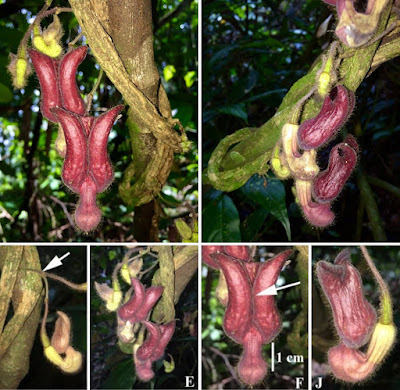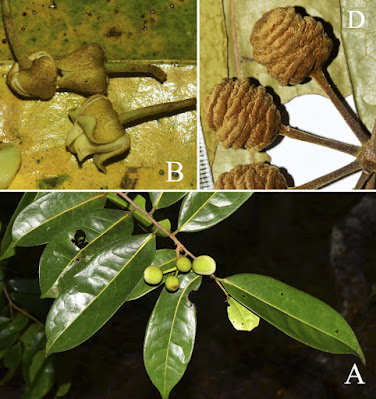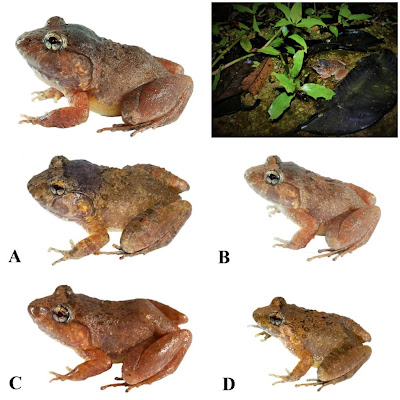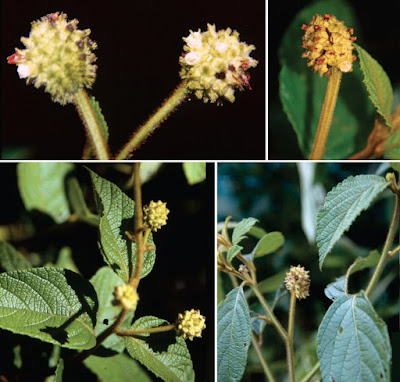[Most Recent Entries] [Calendar View]
Friday, June 4th, 2021
| Time | Event | ||
| 3:07a | [Botany • 2021] Aristolochia vuquangensis (Aristolochiaceae) • A New Species from Central Vietnam
Abstract Aristolochia vuquangensis (Aristolochia subgenus Siphisia), a new species from Central Vietnam, is described and illustrated here. This species is most similar to A. wardiana and A. forrestiana by sharing an ovate to lanceolate-ovate leaf blade and a cylindric or saccate-shaped limb, but it differs principally from the two species in having a densely brown hirsute outer surface of perianth, an oblong-ovate utricle, 1.1–1.5 cm long, an unequally semicircular 3-lobed limb in pre-anthesis, with a revolute median lobe, larger than two lateral lobes, abaxially concave, and lower one-third of the inner surface of limb densely covered by trichomes. A detailed description, illustrations, information on ecology, conservation status, and comparison with two similar species are also provided. Keywords: Aristolochiaceae, Flora of Vietnam, Piperales, Siphisia, Magnoliids Truong Van Do, Hung Viet Nguyen and Khuong Duy Le. 2021. Aristolochia vuquangensis (Aristolochiaceae), A New Species from Central Vietnam. Phytotaxa. 500(1); 37–44. DOI: 10.11646/phytotaxa.500.1.5 Một loài thực vật nữa bổ sung cho khoa học được phát hiện tại Vườn Quốc gia Vũ Quang vừa được đăng tải trên tạp chí chuyên nghành Phytotaxa (500(1): 037-044 ). Loài mới có tên Aristolochia vuquangensis (Mộc hương Vũ Quang) do nhóm nghiên cứu của Bảo tàng thiên nhiên Việt Nam phối hợp với VQG Vũ Quang công bố. Đây là loài mới thứ tám của phân chi Siphisia thuộc họ Mộc hương (Aristolochiaceae) được phát hiện và mô tả ở Việt Nam trong suốt 7 năm qua và là loài thứ 2 của phân chi này được phát hiện ở miền Trung Việt Nam. Loài mới này được mô tả dựa trên phân tích mẫu đã được thu thập trong suốt giai đoạn 2018-2020 tại VQG Vũ Quang, Hà Tĩnh | ||
| 3:20a | [Botany • 2021] Alphonsea annulata (Annonaceae) ตำหยาวสี่ขีด • A New Species from peninsular Thailand
Summary A new species of the genus Alphonsea, A. annulata from peninsular Thailand is described and illustrated. A conservation assessment for A. annulata and a key to Alphonsea species in southern Thailand and Peninsular Malaysia are provided. Key Words: conservation, Miliuseae, taxonomy Alphonsea annulata Leerat. & Chalermglin, sp. nov. ETYMOLOGY. This species is named for its monocarps, which, when dried, are marked by 2 – 7 raised transverse rings. VERNACULAR NAME. [Thailand] Tam yao si khit ตำหยาวสี่ขีด. Charan Leeratiwong, Piya Chalermglin and David M. Johnson. 2021. Alphonsea annulata (Annonaceae), A New Species from Thailand. Kew Bulletin. DOI: 10.1007/s12225-021-09937-4 | ||
| 4:18a | [Herpetology • 2021] Limnonectes pseudodoriae • A New Limnonectes (Anura: Dicroglossidae) from Southern Thailand
Abstract A new species in the dicroglossid frog genus Limnonectes is described from Ko Pha-ngan, Ko Samui, and Ko Lanta Yai Islands in southern Thailand. Males of Limnonectes pseudodoriae sp. nov. lack a caruncle on top of the head and very closely resemble L. doriae (Boulenger, 1887) from Myanmar and western and southern Thailand. However, the new species is distinguished from L. doriae and its congeners using an integrative taxonomic approach of morphology, mitochondrial DNA, and bioacoustics. Limnonectes pseudodoriae sp. nov. differs from L. doriae and its congeners by having a unique combination of morphological characters, including body size; skin texture of the interorbital region, dorsum, and shank; toe webbing; relative size of the inner metatarsal tubercle; and coloration of the tympanum, venter, and ova. The advertisement call of the new species is also readily differentiated from that of L. doriae in temporal parameters. Limnonectes pseudodoriae sp. nov. is highly divergent in mitochondrial DNA from L. doriae and its congeners, but its phylogenetic position within the genus is not resolved. The natural history of the new species is presented, and the geographic range of L. doriae in Thailand is clarified. Keywords: Amphibia; Limnonectes doriae; bioacoustics; mitochondrial DNA; Southeast Asia Limnonectes pseudodoriae sp. nov. Diagnosis: Limnonectes pseudodoriae sp. nov. is assigned to the genus Limnonectes on the basis of its inferred phylogenetic position (Figures 1 and 2), the presence of fang-like odontoid processes on the lower jaw [6,10], and enlarged heads with hypertrophied jaw musculature in adult males [6]. This species can be distinguished from its congeners by having the following combination of characters: (1) Small to medium body size, with SVL of adult males 42.6–48.2 mm (45.2 ± 1.7, n = 18), of adult females 36.0–44.1 mm (40.0 ± 2.8, n = 14); (2) males lacking cephalic caruncles, but having broadened convex skin with densely grained translucent spinules on the interorbital region from the level of the posterior margin of the eyes to the level of the posterior margin of the tympanum; (3) males with enlarged heads with hypertrophied jaw musculature; (4) two enlarged odontoid processes, triangular, sharp-tipped, angled posteriorly on anterior margin of the lower jaw, larger in adult males than females; (5) tympanum dark brown with yellow mottling, horizontal diameter in adult males greater than that of the eye, in juveniles and females less than that of the eye; (6) dorsum with enlarged, oval tubercles, and slightly elongated tubercles, not arranged in rows; (7) dorsal surface of shank covered with small, distinct, moderately dense, homogenously-sized tubercles tipped with translucent spinules; (8) chin and throat yellowish white with dark brown or gray mottling (9) chest, belly, ventral surface of upper forelimb and groin yellowish white; (10) ventral surfaces of forelimbs and hindlimbs orange-yellow; (11) Toe V with raised, but unmovable dermal ridge along outer margin; (12) inner metatarsal tubercle length approximately 35% that of Toe I; (13) toe webbing formula: I0−2II0−2 1 2 III0−(21 2 -3)IV(21 2 -3)−0V; and (14) ova with pigmented poles. Etymology: The specific name pseudodoriae is a noun in apposition. The Greek word pseudo means “false” or “resembling”, in reference to the morphological similarity between the new species and L. doriae. Suggested common names: False Doria’s Fanged Frog (English), Kob Tam Than Lueang กบตามธารเหลือง (Thai). Conclusions: We described a new species of the fanged frog genus Limnonectes (Amphibia, Anura, Dicroglossidae) from southern Thailand, Ko Pha-ngan and Ko Samui Islands (the Gulf of Thailand coast) and Ko Lanta Yai Island (the Andaman Sea coast), using an integrative taxonomic approach based on multiple lines of evidence. Limnonectes pseudodoriae sp. nov. can be differentiated from the most morphologically similar species, L. doriae, and its congeners on the basis of mitochondrial DNA (16S rRNA and ND3), qualitative and quantitative morphology, and advertisement calls. However, the exact sister relationship of the new species remains unresolved, and additional sequence data may be required to resolve these relationships. Limnonectes pseudodoriae sp. nov. is known only from a relatively small geographic area in southern Thailand, where it inhabits mountain streams at mid to low elevations similar to many other fanged frogs. The new species deposits eggs in terrestrial nests near streams that consist of moist, shallow, clay holes covered with leaf litter, and the tadpoles develop in the moist clay of the nest, without free water or in only a small volume of fluid. Additional field sampling is needed to understand the extent of the geographic range and natural history of the new species. Siriporn Yodthong, Attapol Rujirawan, Bryan L. Stuart and Anchalee Aowpho. 2021. A New Limnonectes (Anura: Dicroglossidae) from Southern Thailand. Animals. 11(2); 566. DOI: 10.3390/ani11020566 Simple Summary: New species of frogs continue to be discovered at a rapid rate in Southeast Asia, often as a result of reexamining populations of geographically widespread species using new molecular and bioacoustic tools. Here, we show that members of the fanged frog genus Limnonectes from Ko Pha-ngan, Ko Samui, and Ko Lanta Yai Islands in southern Thailand can be distinguished from the morphologically similar species Limnonectes doriae in molecular, advertisement call, morphometric, and qualitative morphological characters. On the basis of these multiple lines of evidence, we describe the insular populations in southern Thailand as a new species, Limnonectes pseudodoriae sp. nov. The new species occurs near small streams in low to mid-elevation forests and breeds in terrestrial nests consisting of moist, clay depressions in which the eggs and larvae develop. || น้ำตกซองเรือ | ||
| 6:55a | [Botany • 2021] Varronia teguorum (Cordiaceae) • A New Species of Varronia P. Browne from central Colombia
Abstract A new species, Varronia teguorum Fern. Alonso & J.I.M. Melo (Cordiaceae), from central Colombia is described. This new taxon is compared morphologically with V. subtruncata and V. bullata, the species with which it is most easily confused. An identification key for the Varronia species with globose inflorescences from Colombia/northern South America is presented. Keywords: Boraginaceae s.l., Boraginales, Cordia s.l., diversity, Neotropical flora, taxonomy, Eudicots Varronia teguorum Fern. Alonso & J.I.M. Melo, sp. nov. This new species is similar to Varronia subtruncata and V. bullata, but it differs from these two by the presence of a rusty (vs. white to yellow) indumentum covering the stems, leaves and inflorescences, longer (1.5–2 mm vs. < 1.5 mm long) and patent (vs. patent or adpressed) hairs; oblong to ovate-oblong (vs. lanceolate to ovate), larger (7.5–13 × 4.5–7.5 cm vs. < 8.0 × 4.5 cm) leaf blades. Etymology:— The epithet refers to the indigenous Tegua people, who inhabited the base of the Boyacá-Casanare Mountain, bordering the Muiscas people territory (Fernández de Piedrahita 1973). The chroniclers Fray Pedro Simón and B. Fernández de Oviedo highlighted the Tegua’s longevity and their knowledge and use of medicinal plants, which was also acknowledged by the Muiscas neighbors. Distribution and Habitat:— Currently this species is known exclusively from a small sector in the border area of Boyacá and Cundinamarca Departments, at the base of Colombia’s Cordillera Oriental (Figure 4). It grows in very wet tropical forest and in its transition to pluvial submontane forest (5000 and 6000 mm of annual rainfall). It has been exclusively collected at the edge of forests, in exposed areas such as creek margins and road slopes on forest edges, between 500 and 1150 m elevation. Among the species restricted to this region of the mountain base are Brownea enricii Quiñones (1995: 17) (Fabaceae) and Phragmotheca mambitana Fern. Alonso & Jaramillo-Mejía (1999: 125) (Malvaceae). Jose Luis Fernández Alonso and José Iranildo Miranda de Melo. 2021. A New Species of Varronia P. Browne (Cordiaceae) from central Colombia. Phytotaxa. 507(1); 121–130. DOI: 10.11646/phytotaxa.507.1.8 | ||
| 6:02p | [Arachnida • 2021] Zagrotes apophysalis, Cryptodrassus iranicus, Drassodes persianus, Prodidomus inexpectatus, et al. • One New Genus and Nineteen New Species of Ground Spiders (Araneae: Gnaphosidae) from Iran, with other Taxonomic Considerations
ABSTRACT One new genus, Zagrotes gen. nov., and 19 new species of ground spiders (Gnaphosidae) are described from Iran: Berinda bifurcata sp. nov. (♂, Bushehr, Khuzestan; southwestern and southern Iran), Berinda hoerwegi sp. nov. (♂♀, Fars, Ilam, Kermanshah, Kurdistan; western and southcentral Iran), Berlandina artaxerxes sp. nov. (♂ Yazd; central Iran), Cryptodrassus iranicus sp. nov. (♂, Kermanshah; western Iran), Drassodes persianus sp. nov. (♀, Kermanshah, Sistan & Baluchistan; western and southeastern Iran), Echemus caspicus sp. nov. (♀, Golestan; northern Iran), Gnaphosa qamsarica sp. nov. (♀, Isfahan; central Iran), Haplodrassus medes sp. nov. (♂, Fars; southcentral Iran), Haplodrassus qashqai sp. nov. (♂♀, Hormozgan, Khuzestan, Lorestan; southwestern to southern Iran), Marinarozelotes achaemenes sp. nov. (♀, Kohgiluyeh & Boyer-Ahmad; southwestern Iran), Marjanus isfahanicus sp. nov. (♀, Isfahan; central Iran), Nomisia ameretatae sp. nov. (♂, Tehran; northern Iran), Prodidomus inexpectatus sp. nov. (♂, Hormozgan; southern Iran), Scotophaeus anahita sp. nov. (♀, Isfahan; central Iran), Scotophaeus elburzensis sp. nov. (♀, Tehran, Zanjan; northwestern and northern Iran), Sosticus montanus sp. nov. (♀, Ilam; western Iran), Synaphosus martinezi sp. nov. (♂♀, Kohgiluyeh & Boyer-Ahmad; southwestern Iran), Zagrotes apophysalis sp. nov. (♂♀, Hormozgan, Kohgiluyeh & Boyer-Ahmad; southwestern to southern Iran) and Zelotes hyrcanus sp. nov. (♀, Mazandaran; northern Iran). These are the first records of the genera Berinda Roewer, 1928, Echemus Simon, 1878 and Marjanus Chatzaki, 2018 in Iran. Additionally, the previously unknown female of Callipelis deserticola Zamani & Marusik, 2017 is described and illustrated, and Berlandina mesopotamica Al-Khazali, 2020 is recorded in Iran for the first time. Furthermore, Berinda idae Lissner, 2016 syn. nov. (Greece, Cyprus) is synonymized with Berinda infumatus (O. Pickard-Cambridge, 1872) comb. nov. (ex. Heser Tuneva, 2004; Greece, Tanzania, Egypt, Israel, introduced to Japan). Keywords: Middle East, new combination, new record, new synonymy 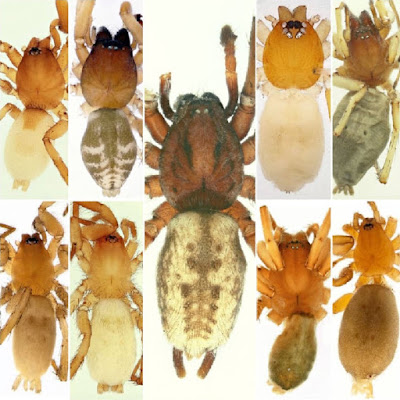 Alireza Zamani, Maria Chatzaki, Sergei L. Esyunin and Yuri M. Marusik. 2021. One New Genus and Nineteen New Species of Ground Spiders (Araneae: Gnaphosidae) from Iran, with other Taxonomic Considerations. European Journal of Taxonomy. 751(1); 68-114. DOI: 10.5852/ejt.2021.751.1381 |
| << Previous Day |
2021/06/04 [Calendar] |
Next Day >> |
